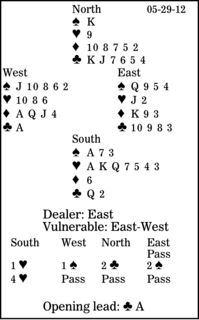Bridge column, May 29: The second deal features defense

How should the defense and play go in four hearts by South?
The first three calls were clear-cut. Then North should have made a negative double, indicating length in both minors (the unbid suits). His actual two-club response promised at least 10 points (or a fabulous nine).
East raised to two spades. Afterward, I mentioned the Law of Total Tricks. Without game-going values in a competitive auction, bid as high as the combined number of trumps. So, if East had the chance to bid three spades on the next round, he should have taken it to indicate his fourth spade, not promise more high-card power.
When South sensibly plunged into four hearts, West was not tempted to bid four spades for two reasons: He had a good chance to defeat the contract, and the vulnerability was unfavorable. (Four spades doubled would have gone down two, minus 500, if South had received a diamond ruff.)
West led the club ace, which had to be a singleton, given the auction and the dummy.
In this situation, East was supposed to send a suit-preference signal to show where his entry lay. Here, with the diamond king and no spade ace, East had to play his club three, the lowest asking for the lower-ranking of the other two side suits.
Now West should continue with a low diamond to East's king. West ruffs the second club but has no winning continuation. When he leads a spade to remove the dummy entry to the clubs, South ruffs a diamond, ruffs a spade, ruffs a diamond, draws trumps, and claims.
** ** **
COPYRIGHT: 2012, UNITED FEATURE SYNDICATE
DISTRIBUTED BY UNIVERSAL UCLICK FOR UFS

